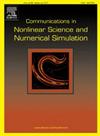Efficient detection of chaos through the computation of the Generalized Alignment Index (GALI) by the multi-particle method
IF 3.4
2区 数学
Q1 MATHEMATICS, APPLIED
Communications in Nonlinear Science and Numerical Simulation
Pub Date : 2025-02-01
DOI:10.1016/j.cnsns.2025.108635
引用次数: 0
Abstract
We present a method for the computation of the Generalized Alignment Index (GALI), a fast and effective chaos indicator, using a multi-particle approach that avoids variational equations. We show that this approach is robust and accurate by deriving a leading-order error estimation for both the variational (VM) and the multi-particle (MPM) methods, which we validate by performing extensive numerical simulations on two prototypical models: the two degrees of freedom Hénon-Heiles system and the multidimensional -Fermi-Pasta–Ulam-Tsingou chain of oscillators. The dependence of the accuracy of the GALI on control parameters such as the renormalization time, the integration time step and the deviation vector size is studied in detail. We test the MPM implemented with double precision accuracy () and find that it performs reliably for deviation vector sizes , renormalization times , and relative energy errors . These results hold for systems with many degrees of freedom and demonstrate that the MPM is a robust and efficient method for studying the chaotic dynamics of Hamiltonian systems. Our work makes it possible to explore chaotic dynamics with the GALI in a vast number of systems by eliminating the need for variational equations.
求助全文
约1分钟内获得全文
求助全文
来源期刊

Communications in Nonlinear Science and Numerical Simulation
MATHEMATICS, APPLIED-MATHEMATICS, INTERDISCIPLINARY APPLICATIONS
CiteScore
6.80
自引率
7.70%
发文量
378
审稿时长
78 days
期刊介绍:
The journal publishes original research findings on experimental observation, mathematical modeling, theoretical analysis and numerical simulation, for more accurate description, better prediction or novel application, of nonlinear phenomena in science and engineering. It offers a venue for researchers to make rapid exchange of ideas and techniques in nonlinear science and complexity.
The submission of manuscripts with cross-disciplinary approaches in nonlinear science and complexity is particularly encouraged.
Topics of interest:
Nonlinear differential or delay equations, Lie group analysis and asymptotic methods, Discontinuous systems, Fractals, Fractional calculus and dynamics, Nonlinear effects in quantum mechanics, Nonlinear stochastic processes, Experimental nonlinear science, Time-series and signal analysis, Computational methods and simulations in nonlinear science and engineering, Control of dynamical systems, Synchronization, Lyapunov analysis, High-dimensional chaos and turbulence, Chaos in Hamiltonian systems, Integrable systems and solitons, Collective behavior in many-body systems, Biological physics and networks, Nonlinear mechanical systems, Complex systems and complexity.
No length limitation for contributions is set, but only concisely written manuscripts are published. Brief papers are published on the basis of Rapid Communications. Discussions of previously published papers are welcome.
 求助内容:
求助内容: 应助结果提醒方式:
应助结果提醒方式:


